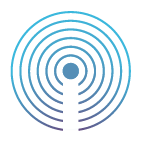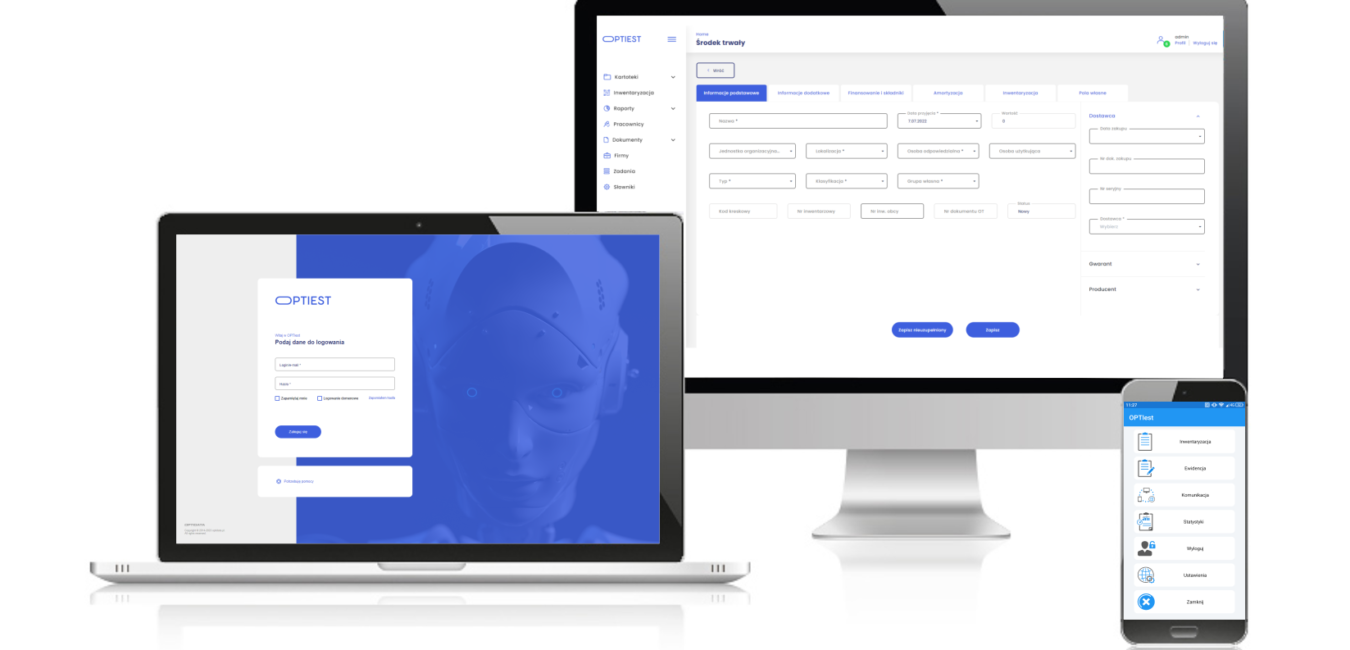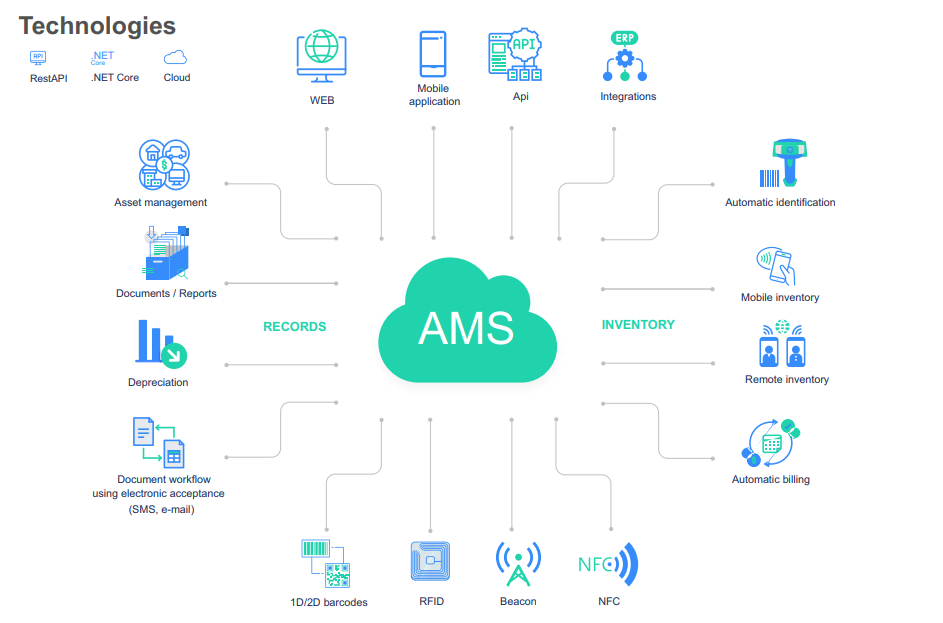



Replace manual record-keeping with automation. Regain control over your company’s inventory and assets using the best solution available. AMS OPTIest® is a market-leading IT system for managing non-current assets, keeping its records and inventory. Fast, secure and transparent asset tracking is possible thanks to the use of 1D / 2D barcode technology and RFID.
The software enables permanent asset labelling thanks to barcode labels and RFID tags that uniquely identify each component. By automating the census process, you can save up to 80% of the time compared to the traditional methods, while guaranteeing reliability and error-free data collection.
System available: Saas or on-premise.
Find more information on the Azure Marketplace.
The fixed asset inventory programme
OPTIest® is not only a programme for recording fixed assets. The software also greatly facilitates the management of fixed assets. It is a reliable tool which cooperates with data collectors, smartphones, printers, all which are used for inventory and mobile handling of accounting processes.
It is worth emphasising that thanks to the numerous functions in the system, you can automate your work and organise asset knowledge. For effective management, you will, therefore, need a stable software, a mobile collector and a bar code printer. These are only three elements that will provide a full overview of the company’s current situation. The OPTIest® system is an open architecture solution that can be perfected and adapted to individual needs. At this moment the software includes the following extensions: warehouse module, web module and OPTIest® ready to RFID.
Digitalisation of asset management using the modern AMS OPTIEST system provides a uniform, digital solution that automates the work of inventory teams and ensures an increase of the assets themselves. Managing the full life cycle of all assets in the AMS OPTIEST system increases the accuracy of asset tracking to 99%and brings a return on investment of up to 500% in the first year of use.

The OPTIest® system can be integrated with any ERP system. Integration mechanisms are always created according to individual expectations, thanks to which their operation is tailored to each client’s needs. We have many years of experience in implementing integration projects that give you a guarantee that the mechanism will work efficiently, reliably and improve the overall management of fixed assets. The medium by which data can be transmitted depends on the capabilities of both systems. Given the OPTIest® system, it can be a simple data exchange using files (txt, csv, xls, xlsx, xml), database views or web services.
The OPTiest® system is based on own and system glossary data, we have listed a few important examples below:
If you are the person in the company responsible for managing fixed assets, you know well how important it is to generate correct and reliable reports. As an authorised person and with the help of an extensive reporting mechanism, you will be able to easily report specific assets, create individual reporting scenarios and save their results to an excel file.
Keep the application under control. The ‘events’ function gives the administrator a preview of all operations performed in the system. As part of the new provisions related to the GDPR, you can manage the rights of users whose passwords are encrypted in the database of the system.
Identify and manage various types of property, taking into account its specificity such as fixed assets and equipment (warehouses, communication devices, IT equipment, software), real estate, small inventory and investment records. The component file is a useful mechanism to improve the management of fixed assets and recording of multi-element property objects such as a computer or office furniture sets for example.
Manage the full asset life-cycle. All operations are recorded in the system; from adoption, movement of assets between employees, locations, organisational units, revaluations, improvements, to liquidation or sale. Their implementation in the field is possible using specialised portable computers. It is possible to carry out all record transactions on a portable data collector and further transmit the data to the central database of the OPTIest® system in order to confirm their performance.
Asset management in the field? Our system will enable automatic physical inventory which will be possible using mobile data collectors. The given object is then identified by scanning the label with the code.
The OPTIest® system has an extensive inventory execution and settlement module using automatic identification technology to tag and inventory assets using barcode labels, mosaic code labels and RFID tags. Inventory may include fixed assets, components, equipment and property. There are 4 types of physical inventory kept in the system: by location, by organisational unit, by a responsible person, or by using groups of the above-mentioned factors simultaneously.
Automate your work with mobile data collectors where data will be entered by simply scanning the code labels. Data collectors are small portable computers with built-in barcode readers. During the inventory, barcodes are easily and quickly read by the barcode reader. The data is saved in the collector’s memory. The collected information can be sent to a computer programme whose task is to analyse it. As a result, you can get precise information in the form of discrepancy reports, data on what is in the equipment of individual employees and in what locations particular items are located. All this has an impact on the effective and efficient management of fixed assets.
Advantages of conducting inventory in the OPTIest® system:
The AMS OPTIest® ready to RFID is the perfect extension of the system that is responsible for managing fixed assets within a company. Thanks to this solution, it is possible to support RFID tags in addition to standard barcode containing labels. The module is responsible for data transmission between the reader and the identifier as well as data collection and processing. The collected information on the RFID tags can be used for standard asset handling and inventory processes. The additional extension consists of elements such as the RFID identifiers, RFID readers and software. Discover the benefits of RFID technology in practice.
The Web module supplements the OPTIest® system and supports the management of fixed assets in an enterprise with a dispersed location structure. The current browser version has the possibility of performing operations such as entering assets, accepting assets, changing the place of use and liquidation. In addition, the user has access to the documents awaiting acceptance or rejection. The OPTIest® Web module supports Internet Explorer, Mozilla Firefox, Google Chrome.